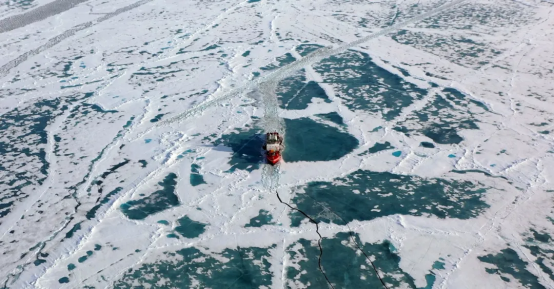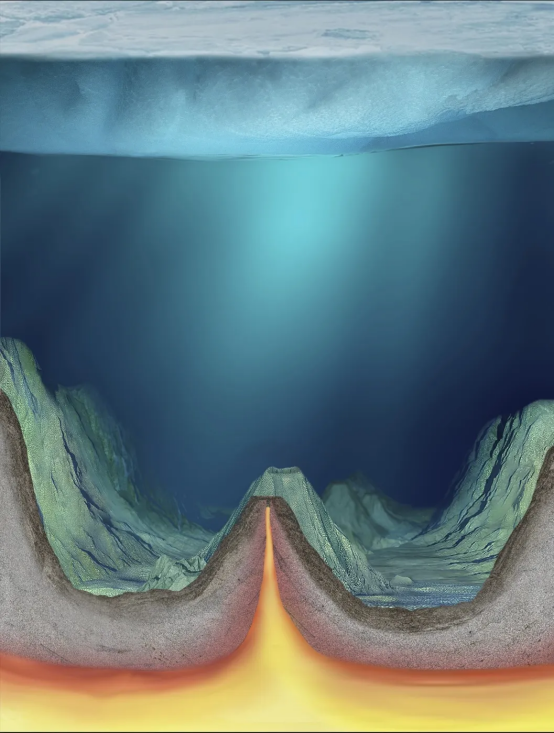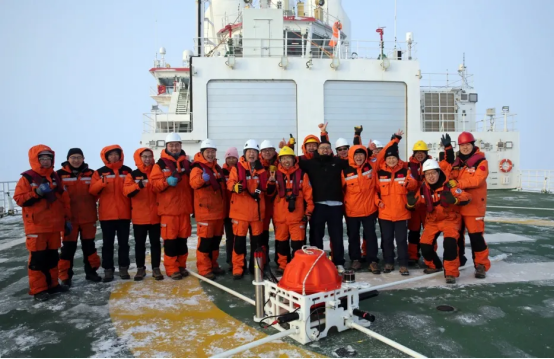颠覆国际对洋壳形成机制认知 我国科学家最新研究登上《自然》杂志
Title: Chinese Scientists' Latest Research on Oceanic Crust Formation Mechanism Shakes International Understanding, Published inNature
The latest research by the research team led by Academician Li Jiabiao from the Second Institute of Oceanography, Ministry of Natural Resources, has been published online today in the international authoritative academic journal Nature, shaking international understanding of the formation mechanism of the oceanic crust. The research results indicate that the "dual mechanism of active and passive mantle upwelling" controls the global mid-ocean ridge system, further revealing and improving the formation mechanism of the global oceanic crust.

As we all know, the internal structure of the Earth is divided from the outside to the inside into the crust, mantle, and core. The crust, the outermost layer of the Earth's surface, is primarily composed of rocks and soil. The crust beneath the oceans, which cover about 70% of the Earth's surface, is known as the oceanic crust. How can we comprehend the latest research achievement, the "dual mechanism of active and passive mantle upwelling," in layman's terms? And why does this research shake international understanding of the formation mechanism of the oceanic crust?
The crust, a solid spherical layer closely related to humans, is the outermost layer of the Earth. Most minerals and seismic activities occur within the crust. Academician Li Jiabiao of the Chinese Academy of Engineering explained that the crust can be divided into continental crust and oceanic crust, with the oceanic crust accounting for about two-thirds of the total crust area and still growing through mid-ocean ridges and disappearing at subduction zones. So why does the continental crust change less while the oceanic crust continues to grow? What is a mid-ocean ridge, where does the oceanic crust originate, and where does it disappear?
Li Jiabiao said, "Mountains on land are mainly formed by tectonic compression, while mid-ocean ridges, the mountain ranges in the middle of oceans, are quite the opposite. They form due to tectonic extension. When the tectonic plates separate, magma rises from the mantle, cools in seawater, and combines with surrounding hardened rocks to form mid-ocean ridges and new oceanic crust. The newly formed oceanic crust pushes against the existing crust on both sides of the mid-ocean ridge, continually expanding outward. Ultimately, due to its denser texture than the continental crust, it subducts back into the mantle at the boundary between tectonic plates."
In the early stages of Earth's formation, the continental crust began to cool and form, with relatively minor changes since then. However, due to tectonic extension, the oceanic crust drags the mantle beneath it, causing magma to passively rise continually in a repetitive process, leading to its continuous growth.
Imagine draining all the water from Earth; it would not be a perfect sphere but uneven, with high areas representing the continental crust, averaging 35 kilometers thick, and low areas representing the oceanic crust, generally thought to be between 6 and 7 kilometers thick. Water flows to lower places, forming oceans over the oceanic crust. What Li Jiabiao described is the traditional theory of passive mantle upwelling, proposed by American marine geologist Harry Hess in the seabed expansion theory in the 1960s. According to this theory, the speed of oceanic crust formation depends on the rate of tectonic plate expansion. Faster expansion results in greater and quicker magma ejection, leading to faster oceanic crust formation. However, Li Jiabiao said that the research team's latest findings have overturned this traditional understanding.
The international authoritative academic journal Science has proposed 125 fundamental scientific questions unknown to humanity, with how the Earth's interior operates listed as one of the top ten questions. Our work is a step-by-step answer to the mechanism of Earth's internal operation from the crust to the mantle, serving as a key to unlocking this question. In the Pacific Ocean, the expansion rate of the oceanic crust can reach 10 centimeters per year, while the Atlantic Ocean has a rate about half that of the Pacific, and the Southwest Indian Ocean only 1.4 centimeters per year. The slowest-expanding mid-ocean ridge in the world is the Gakkel Ridge in the Arctic Ocean, with an expansion rate of about 1 centimeter per year. According to the classic passive mantle upwelling model, it is not difficult to infer that the Gakkel Ridge has a very slow expansion rate, resulting in minimal magma formation and potentially a very thin or even absent crust. However, during China's 12th Arctic Scientific Expedition, we discovered a surprisingly thick crust exceeding 9 kilometers at the Gakkel Ridge, leading us to propose dual controlling factors of passive and active mantle upwelling.
Tectonic plate expansion causing magma to passively rise from mid-ocean ridges is easy to understand. But what is active upwelling, and when does it occur? Li Jiabiao explained that if we simplify the mid-ocean ridge as the valve on a pressure cooker, passive upwelling is like someone removing the valve, causing the contents to passively eject. In contrast, active upwelling resembles the pressure inside the pressure cooker reaching a certain level, actively pushing up and ejecting the gas through the valve.
Passive mantle upwelling is relatively easy to understand and has been verified in rapidly expanding mid-ocean ridges, leading to widespread belief in it. However, we have found that regardless of rapid, slow, or ultra-slow expanding mid-ocean ridges, both active and passive upwelling mechanisms are operating simultaneously. During mantle upwelling, solid rocks melt into fluids, and the molten magma carries away heavier iron elements from the solid rocks, leaving lighter magnesium elements. This makes the mantle in the melting zone beneath the mid-ocean ridge lighter than other areas, akin to a "hydrogen balloon" pushing upwards. In rapidly expanding mid-ocean ridges, this "hydrogen balloon" has not accumulated enough to rise actively before being released. However, in ultra-slowly expanding mid-ocean ridges, due to the slow expansion rate, more of these lighter mantle materials accumulate per unit distance, forming a thicker crust and highlighting the process of active upwelling.

Yet, why had such a significant research discovery not been achieved in previous decades? Li Jiabiao explained that scientists previously hoped to find the ideal "thinnest crust on Earth" at the Gakkel Ridge in the Arctic Ocean to validate this hypothesis. However, located at about 85°N, it is nearly permanently ice-covered, making it impossible to effectively retrieve seabed detection equipment placed there. Therefore, it has been a gap in the scientific community to investigate the deep crustal conditions and conduct large-scale seabed active source detection under thick sea ice.
Li Jiabiao said, "In 2020, with the launch of the 'Xuelong 2,' we saw hope for exploring the Arctic seabed. The icebreaker enabled the seabed detection equipment placed to be retrieved efficiently. During China's 12th Arctic Scientific Expedition in 2021, our team used self-developed key technical equipment such as sub-ice seabed seismographs, seabed geomagnetic instruments, baseline positioning systems, and autonomous robots. Of the 43 seismographs deployed, 42 were successfully retrieved, and of the six geomagnetic instruments, five were retrieved, with a retrieval rate of 97.7%. This broke the international assertion that seabed seismograph detection in densely iced areas of the Arctic was impossible and ultimately brought back unexpected research data, laying a solid foundation for this theory's proposal."

So, what is the significance of this theory for humanity? How will it guide current scientific research, production, and life? Li Jiabiao pointed out that besides changing our understanding of the oceanic crust itself, it is likely to alter our approach to mineral exploration in ultra-slowly expanding mid-ocean ridges, opening up new horizons for humanity to understand, manage, and protect the oceans.
Li Jiabiao said, "This definitely changes our understanding of the traditional structure and formation mechanism of the oceanic crust, applicable not only to the Gakkel Ridge but also to ultra-slowly expanding mid-ocean ridges such as the Southwest Indian Ocean. Meanwhile, in mineral exploration, besides magmatic activity, there is also hydrothermal activity, where seawater infiltrates deep into the seabed crust through rock fractures or tectonic fault zones, bringing out a large amount of metallic elements and forming hydrothermal sulfide deposits, which are critical strategic minerals. Our research shows that ultra-slowly expanding mid-ocean ridges can also have abundant magmatic activity, potentially forming more hydrothermal vents, which may even be more persistent and have larger total mineral quantities. This also overturns our understanding of energy and mineral exploration. We have initiated an international scientific project for the UN Decade of Ocean Science and Exploration, involving countries such as the United States, Canada, and Russia. We will jointly explore this frontier scientific research area."












请先 登录后发表评论 ~